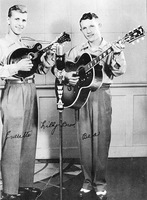 | Back to e-WV
| Back to e-WV
 The West Virginia Encyclopedia
The West Virginia Encyclopedia
 | Back to e-WV
| Back to e-WV
 The West Virginia Encyclopedia
The West Virginia Encyclopedia

Bluegrass music was developed in the 1930s by Kentucky mandolinist Bill Monroe, whose band was called the Blue Grass Boys in honor of his home state. The music combines acoustic guitar, mandolin, banjo, fiddle, and bass fiddle with close vocal harmonies. It draws heavily from the southern mountain instrumental and vocal traditions. It was also influenced by Southern blues, spirituals, church singing, and jazz.
This was a new concept in an era when country or ‘‘hillbilly’’ musicians performing in old-time string bands and jug bands sometimes compromised musical integrity for comic effect. With this new structured and serious approach to performance and the new significance given to the development of vocal harmonies, bluegrass became a high-energy music form. It has in turn had a dramatic impact on the subsequent directions and sounds of mainstream styles such as country, folk, and rock ’n’ roll music, while being performed throughout the world.
West Virginia musicians were well represented during the 1940s and 1950s, the formative years of bluegrass, and continue to be today. The Lonesome Pine Fiddlers formed in Bluefield in 1938 with Ezra Cline, Curly Ray Cline, and Ned Cline. The Fiddlers performed with a variety of personnel, including Ray and Melvin Goins, until the mid-1960s. Curly Ray Cline eventually left the Fiddlers to play fiddle with the Stanley Brothers and then Ralph Stanley.
The Lilly Brothers of Raleigh County, with Everett on mandolin and Bea on guitar, introduced bluegrass to a new audience when they relocated to Boston in 1952, where they performed with Tex Logan and Don Stover as the Confederate Mountaineers. Before the move Everett also played as a member of the Foggy Mountain Boys, the Flatt and Scruggs band, in 1950, appearing on classic recordings such as ‘‘Somehow Tonight’’ and ‘‘ ’Tis Sweet to be Remembered.’’ Stover played many years with the Lillys and is recognized as a banjo pioneer whose strong, clean style ranks him among the top players of any era.
Wilma Lee and Stoney Cooper, of Valley Head and Harman respectively, were a married couple who along with their band, the Clinch Mountain Clan, became stars of WWVA’s Wheeling Jamboree in the late 1940s. In 1957, they became regulars on the Grand Ole Opry. With Stoney on fiddle and Wilma Lee playing guitar and banjo, they achieved commercial success in country music in the late 1950s and early 1960s.
Mercer County’s Hazel Dickens played bass and sang harmony in the 1960s with the Greenbrier Boys. While better known for her solo folk singing, Dickens in 1994 was the first artist to be awarded the Merit Award for contribution to bluegrass music by the International Bluegrass Music Association. In 2001, she received a National Heritage Fellowship from the National Endowment for the Arts.
West Virginia’s historically strong contingent of fiddlers is evident in bluegrass. Charlie Cline of Gilbert fiddled on some classic 1950s Bill Monroe instrumentals such as ‘‘Wheel Hoss’’ and even filled in on mandolin, Monroe’s own instrument, when Monroe was injured in 1955. Joe Meadows performed for years with Jim and Jesse and the Virginia Boys in the 1970s. Buddy Griffin of Braxton County performed on fiddle and banjo with the Goins Brothers, and Boone County’s James Price played fiddle with Ralph Stanley.
Important bands from the 1970s and ’80s also had West Virginia contributors. Guitarist Dudley Connell of Scherr was a founding member of the Johnson Mountain Boys in 1978. Fiddler-mandolinist Tim O’Brien of Wheeling was a founding member of the contemporary bluegrass band Hot Rize in 1979 and continues to perform and produce with the major names in bluegrass music.
Perhaps the most enduring legacy of bluegrass in the Mountain State is its accessibility and status as a music of the people. Expensive equipment is not necessary and the instruments are easy to transport to gatherings where people play, share, and learn tunes. In the true oral tradition, the young learn from the experienced players. Bluegrass is played in the home, at campsites, and at music festivals, affording many people the enrichment of firsthand musical experiences in their lives.
Written by Mark Payne
Larkin, Colin, ed. The Virgin Encyclopedia of Country Music. London: Virgin Pub., 1998.